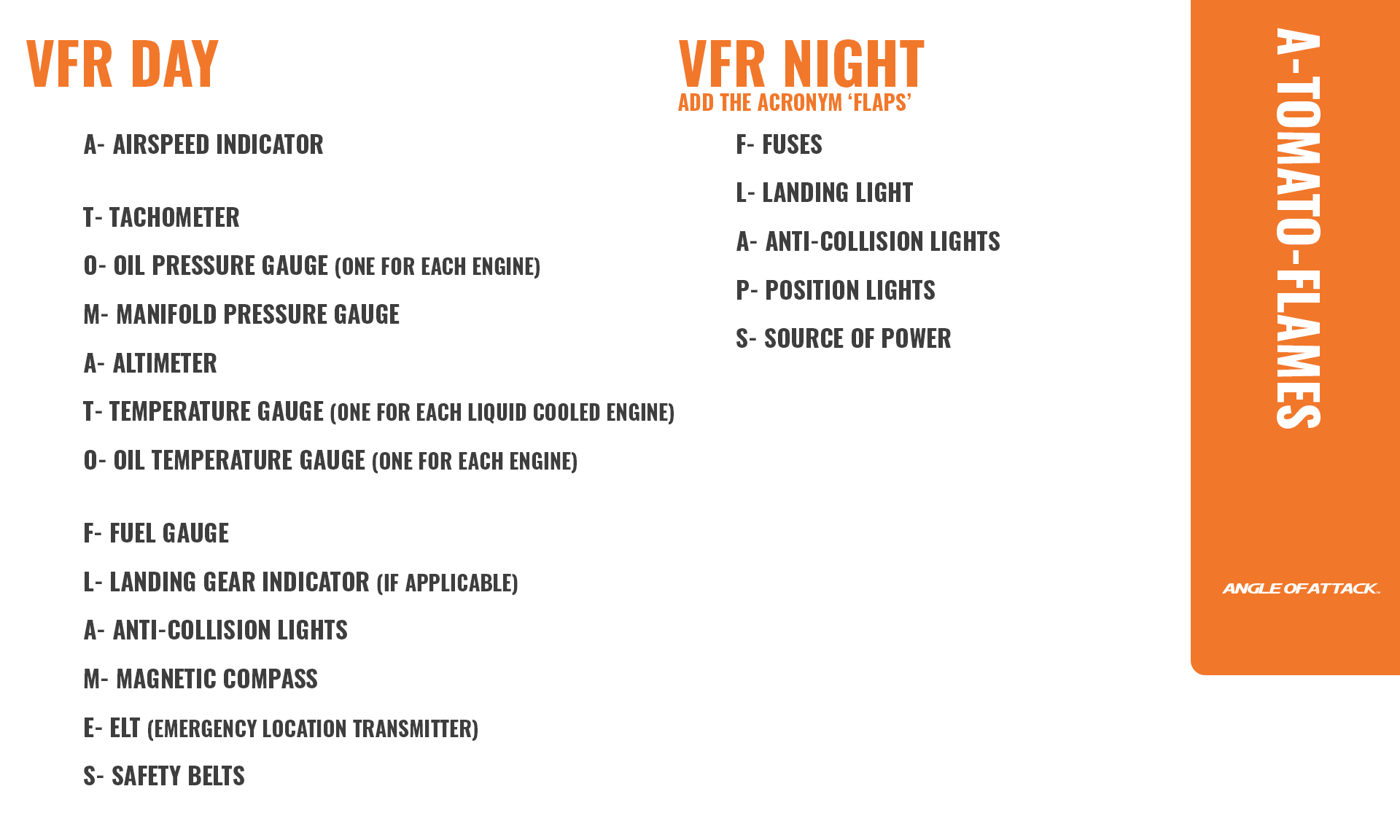
When you first hear the term “A TOMATO FLAMES” you might mistake it for the name of a spicy dish. Sadly, it’s not. A TOMATO FLAMES is the acronym used for the list of items you need working on your airplane for a VFR flight, as required by FAR 91.205. Additionally, if you are flying VFR at night, you need A TOMATO FLAMES + “FLAPS”.
 If any of these items are not working, your airplane is legally grounded until you get it fixed.
If any of these items are not working, your airplane is legally grounded until you get it fixed.
It can be tempting to still go flying even if one minor light isn’t working, but you should not do it. If any of these items is not functioning, in the eyes of the FAA, your insurance company, and a potential jury your airplane is “unairworthy.”
If you get in an accident in an unairworthy condition, even if it didn’t contribute to the actual cause of the accident, you’re what we call in the legal world… “dead to rights.” An insurance policy’s coverage is likely voided by an unairworthy aircraft. Your license will almost assuredly be revoked or suspended and heaven forbid you end up in a courtroom and the word “unairworthy” is spoken to a judge or jury…don’t do it.
Why are these required?
In aviation, it all comes down to one thing: Safety. These items are, in the FAA’s mind, the minimum equipment you need for a safe flight. In reality, there are many more items you need to ensure a safe flight. You should think of this list as the lowest bar.
Just as you create personal minimums for flying in bad weather, you should create personal minimums for flying with certain equipment down. For example, as a “child of the magenta line” (someone who grew up with GPS), I won’t fly cross country with my GPS/ForeFlight out of service. Others won’t fly with their auto-pilot or pito heat inoperative.
Whatever you choose as your personal minimum equipment list, it should be more than what your manufacturer tells you in your Pilot Operating Handbook. It should certainly be much more than the list provided above.
Remembering A TOMATO FLAMES + FLAPS is not just important for the checkride, but important throughout your flight career. The best way to remember this for your evaluation is to write out the acronym and fill in the blanks. Angle of Attack’s Private Pilot Checkride ACE helps you prepare for every acronym you need to know because there can be a lot of them.
How Do I Know When an Instrument is Inoperative?
The obvious answer to this is “it’s not working.” However, anybody who’s been in an airplane knows that isn’t as easy as it sounds.
Take for example your fuel gauge. This is required by A TOMATO FLAMES, but fuel gauges in aviation are notorious for being less than accurate. Newer model airplanes have much more reliable fuel indicators. But some of the old models can be off by 5 to 10 gallons.
Here, the importance of a good pre-flight check cannot be understated. Cross-check your fuel indicators when you flip the master switch. The actual number you see when you put the dipstick in the tank. When doing a preflight, it’s easy to just go down the list and check things off. But you need to be thinking of the big picture the entire time. Just because the fuel gauge came alive, does not mean it’s up to FAR 91.205’s standards.
If you are having trouble with identifying any of these items or knowing if they are working you should check out Angle of Attack’s Online Private Pilot Ground School. The team walk you through every regulation you need and break it down. So you aren’t just prepared for the checkride, but prepared to be the best pilot you can be.

Michael Brown grew up flying on the banks of the Tennessee River in Chattanooga, TN. He obtained his private pilot’s license in high school and has instrument and seaplane ratings. Michael graduated from Texas Christian University, where he founded the school’s flying club, with a double major in Business and Communications. He is currently a law student at Tulane University, studying transportation law. Michael was named the Richard Collins Young Writing Award winner and has had his legal writing recognized by the American Bar Association’s Air & Space Subcommittee. When he is not flying or studying, Michael enjoys riding his bike and cheering on his Atlanta Braves.

Stay Connected
Be the very first to get notified when we publish new flying videos, free lessons, and special offers on our courses.





